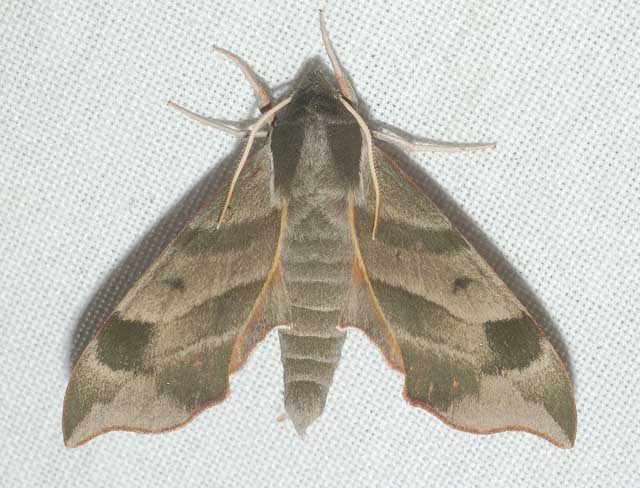Tompkins County
Sphingidae

Darapsa myron, Ithaca, Tompkins County, New York,
August, 9 2010, courtesy of Meena Haribal.
|
|
Updated as per personal communication with Bill Evans, 2006; May 26, 2010; June 4, 2013 Updated as per James P. Tuttle's The Hawk Moths of North America, May 26, 2010 Updated as per personal communication with Meena Haribal, May 26, 2010; July 8, 2012 |

Darapsa myron, Ithaca, Tompkins County, New York,
August, 9 2010, courtesy of Meena Haribal.
A special thanks goes to Bill Evans of Danby who has
begun to send me sightings for Tompkins County, May 2006.
Bill's sightings are recorded as "BE".
Bill writes, June 2, 2013, "I had my first Darapsa choerilus at my home in Tompkins Co., NY last night (pic attached). Feel free to use the pic for your
website. I should note that this is the first instance I've recorded this species in the past eight years of active mothing during May-June."
A "WO" after the species name indicates that I have no confirmed reports of this species in Tompkins County, but I (William Oehlke) expect that this moth is present. A "USGS" indicates the moth is reported on the USGS website and/or in Lepidoptera of North America, #1. Distribution of Silkmoths (Saturniidae) and Hawkmoths (Sphingidae) of Eastern North America, an excellent little booklet available through Paul Opler.
Please help me develop this list with improved, documented accuracy by sending sightings (species, date, location), preferably with an electronic image, via email to Bill Oehlke.
Visit Sphingidae of the Americas to access similar Sphingidae lists for all US states and counties, all Canadian provinces, Mexico, all Central and South American countries. For many of the US counties (Tompkins )there are larvae thumbnail checklists available via the individual state files.
Visit North American Catocala to access pictoral checklists for Catocala (underwing moths) for all US states and all Canadian provinces.
Many thanks also to Meena Haribal who has been keeping records for Ithaca.
Meena writes, July 8, 2012, "I went to my moth sheet at 5.20 am and was pleasantly surprised to see a
large hawkmoth (Sphinx kalmiae) on the sheet. After some pictures, I tried to take a picture
of him on a plant. So I transferred him to a privet. I took some more
photos. Then I wanted him on the green leaves. So put him there when he
dropped down. I could not relocate him in spite of searching for him
thoroughly. I thought he left right under my nose. So then I concentrated on
other moths at the sheet. Then I heard the agitated catbird on the privet
and suddenly he flew, and then I saw he was chasing the hawkmoth. Hawkmoth
first took off straight up and then changed its direction and headed north
in open patch. Catbird with zest followed him. The moth did some ups and
downs and catbird still in pursuit then he flew to the front of the house. I
lost sight of them. So I ran to see if the catbird succeeded. I found
catbird on a branch looking like a failure and a moment later he was back
near the moth sheet. So I presume the hawkmoth won!
"It was neat chase and was happy to know catbird cannot outsmart the
hawkmoth, hey that is why they are called hawkmoths I guess, they fly like
hawks! But also, I was unhappy that catbird has keener eyes than mine. I
could not locate the moth, but he did! The reason I was looking for the moth in
first place was that I did not want him to become catbird's breakfast."
Sphinginae subfamily
Ceratomia undulosa June 7, 2008; July 12, 2009, Ithaca, Meena Haribal.
Smerinthini Tribe:
Amorpha juglandis May 13, 2010, Bill Evans.
Pachysphinx modesta May 28, 2009; June 7, 2008, July 17, 2012, Ithaca, Meena Haribal.
Paonias myops June 7, 2008, Ithaca, Meena Haribal.
Macroglossinae subfamilyDilophonotini tribe:
See Hemaris comparison to help distinguish the next three species.
Philampelini tribe:
Macroglossini tribe:
|
Enjoy some of nature's wonderments, giant silk moth cocoons. These cocoons are for sale winter and fall. Beautiful Saturniidae moths will emerge the following spring and summer. Read Actias luna rearing article. Additional online help available.
Eggs of many North American species are offered during the spring and summer. Occasionally summer Actias luna and summer Antheraea polyphemus cocoons are available. Shipping to US destinations is done from with in the US.
Use your browser "Back" button to return to the previous page.
This page is brought to you by Bill Oehlke and the WLSS. Pages are on space rented from Bizland. If you would like to become a "Patron of the Sphingidae Site", contact Bill.
Please send sightings/images to Bill. I will do my best to respond to requests for identification help.
 Show appreciation for this site by clicking on flashing butterfly to the left. The link will take you to a page with links to many insect sites. |